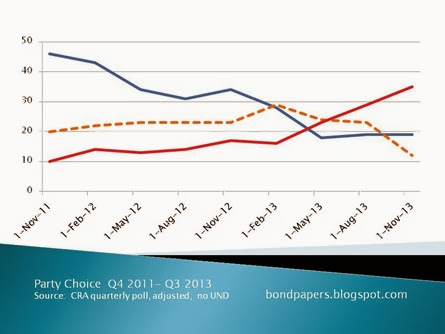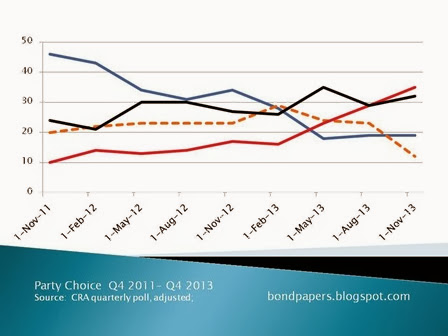Premier Kathy Dunderdale doesn’t govern by polls.
That’s what she told reporters – yet again – as they asked her about yet another poll that showed the provincial Conservatives aren’t doing so well with eligible voters.
Then Kathy explained to reporters that the polls told her that she and her colleagues must do a better job of communicating with the people of the province. Oh yes, and she’d happily “take” the improvement in the satisfaction with her administration.
Dunderdale wasn’t the only one having some problems with the results of the Corporate Research Associates November poll numbers. New Democratic Party leader Lorraine Michael blamed her party’s dramatic drop on the two guys who left her caucus. Never mind that the Dipper problems showed up in the polls well before this past quarter.
Let’s dig into this latest set of polling numbers though and see if we can help Kathy and Lorraine figure out what the polls results mean.
For starters, the CRA poll results for November are identical to the ones MQO obtained in October for NTV, you can go back to the post from October 31 to get a basic comment on the numbers and what the trends mean.
In a nutshell: the NDP did drop. The Conservatives are in the middle. The Liberals are on top. Let’s look at the longer term trending.
Two years changes everything
The chart is an updated version of one we have been using here for a while. It shows the CRA party choice results as a share of all respondents, not just decideds. The parties are represented by their colours. Undecided, won’t vote, and no answers are lumped together as the black line.
The Dippers Remain Stronger than Usual
According to CRA’s numbers the New Democrats have been basically flat-lined in the mid-20s since early 2012. There was a modest bump up, for no apparent reason, in February. Then it was back to the mid-20s until this quarter when the Dipper numbers went down about 10 points.
Whatever drop that happened in the past three months, the NDP were going nowhere according to CRA’s numbers. They weren’t losing anyone but they also weren’t gaining. Lorraine Michael’s personal numbers (choice for Premier) dropped by about half but given how badly she personally handled the caucus crisis, that’s not the least bit surprising.
It’s not unprecedented, as CRA’s Don Mills told CBC. Political leaders have flamed out before. What Mills really should have noted is that the current NDP level is actually still well above the norm for the NDP in Mills’ polling. Between February 2001 and November 2003, the NDP never climbed above five percent of eligible voters (as a share of all respondents). From August 2006 until early 2011, the NDP averaged around the same level. In other words, the NDP are doing better right now than they have for most of the past dozen years or so.
Conservatives down to the hard core
The long slow drop for the Conservatives began in early 2010, well before Danny Williams skedaddled, and it looks like they have finally hit a floor at 18%. They’ve been at that level for the past three quarterly polls. It looks like the Conservatives have found their hard core of voters who won’t abandon them at any cost.
Note that the Conservatives are only seven percentage points ahead of the New Democrats. When you look at the way CRA presents the figures you could come to the mistaken conclusion that the Conservatives are doing far better than they are and that the NDP are doing worse.
Given the CRA margin of error for most of its polls, these two parties could wind up in a tie or change places with a relatively modest change over the next couple of quarters. For example, if the Dippers punted Lorraine in the spring and brought in a newer, more dynamic leader, the party might actually challenge the Conservatives for second place.
More importantly, though, the Dippers still have the kind of strength that could threaten the Conservative traditional bedrock in St. John’s. A seat trend assessment will likely show the Liberals would gain seats in metro St. John’s with these poll numbers, the fact remains that the New Democrats and the Conservatives would be duking it out and likely cancelling each other out. That’s what would help give the Liberals a bit of gain.
Merry Christmas, Liberals
The CRA poll shows the political story of 2013, namely the dramatic rise of the Liberals and Dwight Ball starting in early 2013. Their rise has been meteoric and using CRA’s own numbers that’s what Don Mills should have been talking about, if he wanted to talk about something unprecedented.
Sometime last spring, eligible voters decided to move to the Liberals. Why they moved is open to interpretation, but there is no question that they moved and did so quickly. Take a look at the vote results without the undecideds in it and you can see the sudden and sharp climb for the Liberals: their share of voters doubled in the space of three quarters.
One interesting thing to note here is that Ball is running slightly ahead of his party (39% versus 35%). Lorraine Michael is running farther ahead of her New Democrats (18% to 12%), just as Kathy Dunderdale is out in front of her Conservatives (25% to 19%).
That suggests that voters perceive the entire Liberal team more favourably than they view the other two parties. Arguably, the NDP and the Conservatives have some bigger issues to tackle than just leadership problems if they want to turn around public perceptions of their parties.We’ll get back to this in the next month or so in the year-end commentaries.
Don’t Forget the Undecideds
The conventional interpretation of these poll numbers seems to be that the Liberals have grown at the expense of the New Democrats.
Look at the longer term trends and all the numbers and you seem something else. The Liberal climb started back in the spring. The Dipper numbers stayed level. The Conservatives dropped. The growth was in the Liberal and undecided numbers. In other words, the Liberals gained initially from the Conservatives and their most recent growth seems to be from the NDP.
Note that the UND numbers have gone up slightly, again. Now CRA’s undecideds are not necessarily people who normally vote. A good many of them are people who never vote. They are not up for grabs.
But somewhere in there are a few people who are disaffected from one of the parties – most likely the Conservatives who normally vote. They would be up for grabs. One or another of the parties could swing them. It all depends on who they are and what motivates them.
Zero Sum
These poll results show pretty clearly a hard truth of politics that some people ignore at their peril: politics is a zero sum game. A gain by one party comes at the expense of one or both of the others
